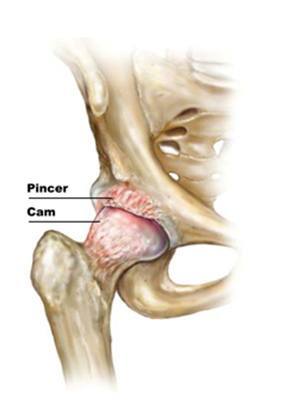Femoro Acetabular Impingement FAI
Femoroacetabular impingement (FAI), commonly referred to as “Hip Impingement” occurs when there is increased bony friction in the hip joint due to bony irregularities causing pain and decreased motion. The femoral head and acetabulum rub against each other creating cartilage damage and pain to the hip joint. The damage can occur to the articular cartilage (the smooth white surface of the ball or socket) or the labral tissue (the lining of the edge of the socket) during normal movement of the hip. The labral tissue or articular cartilage can fray or tear after repeated friction. Over time, more cartilage and labrum is lost due to repetitive damage until eventually the femur bone and acetabulum bone impact on one another. Bone on bone friction is commonly referred to as osteoarthritis.
FAI impingement generally occurs as two forms – cam and pincer, or a combination of both:
- CAM Impingement – The Cam form of impingement results with an aspherical femoral head and neck. This “out of roundness” causes abnormal contact between the femoral head/neck junction and acetabulum resulting in labral tears
- PINCER Impingement – The Pincer form of impingement is when the socket or acetabular rim has overgrown and is too deep. It covers too much of the femoral head resulting in the labral cartilage being pinched. The Pincer form of impingement may also be caused when the hip socket is abnormally angled backwards (acetabular retroversion) causing abnormal impact between the femoral head and the rim of the acetabulum
Most FAI diagnoses are a combination of both CAM and Pincer abnormalities

Symptoms of FAI
Symptoms of femoroacetabular impingement can include:
- Groin pain associated with hip activity including walking, sitting, standing, stair climbing, running, and squatting
- Complaints in the front, side, or back of the hip
- Pain may be described as a dull ache or sharp pain
- Patient may complain of locking, catching, clicking sensation in the hip
- Pain often occurs to the inner hip or groin area after prolonged sitting or walking
- Pain may travel down the thigh to the knee
- Difficulty walking uphill
- Restricted hip movement
- Lower back pain
- Pain in the buttocks or outer thigh area
Risk Factors
A risk factor is something that is likely to increase a person’s chance of developing a disease or condition. Risk factors for developing femoroacetabular impingement may include the following:
- Athletes such as football players, hockey players, and weight lifters
- Heavy laborers
- Congenital hip dislocation
- Anatomical abnormalities of the femoral head or angle of the hip
- Legg-Calves-Perthes Disease: a form of arthritis in children where blood supply to bone is impaired causing cartilage and bone breakdown
- Trauma to the hip
- Inflammatory arthritis
Diagnosis
The hip should be evaluated by an Orthopedic hip surgeon for proper diagnosis and treatment. Clinical evaluation should include:
- Detailed medical history
- Comprehensive physical examination
- Diagnostic studies including X-rays, MRI and CT scans if indicated
Treatment Options
Conservative treatment options refer to non-surgical management to address the problem. Nonsurgical management of FAI will probably not change the underlying abnormal anatomy and biomechanics of the hip, however, it may offer pain relief and improve mobility and activity levels.
Conservative treatment measures include:
- Rest
- Activity modification and limitations
- Anti-inflammatory medications
- Physical therapy
- Injection of PRP, stem cells, or steroids into the hip joint
Surgical treatment
Hip arthroscopy to repair/correct femoroacetabular impingement is indicated when conservative measures fail to provide relief to the patient. Hip arthroscopy, also referred to as minimally invasive surgery, is performed through very small incisions to evaluate and treat a variety of hip conditions
Dr. Gupta to give a lecture series at Georgetown yoga "Healthy Movements Workshop" focused specifically on hip, knee, and shoulder injury prevention and those patients with existing injuries in April and May.
Dr. Gupta is now "board certified" in Orthopedic Surgery.
Dr. Gupta to present Orthopedic Lecture Series with Sentara Northern Virginia Medical Center titled "Don't Let Hip Pain Slow You Down: Understanding Your Options", September 7th, 2016 at Hilton Garden Inn Woodbridge at 6pm.
Dr. Gupta to present third part of his lecture series on "Master Mobility" at Spark Yoga. His next lecture with be on "Mastering Mobility Of Your Knees" on September 18th at The Shops at Pershing, 2201 N Pershing Dr, Arlington, VA 22201










